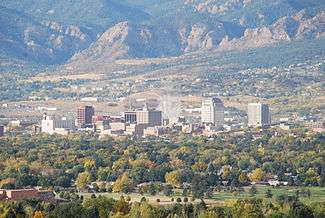Colorado Springs Airport
| City of Colorado Springs Municipal Airport | |||||||||||||||||||
|---|---|---|---|---|---|---|---|---|---|---|---|---|---|---|---|---|---|---|---|
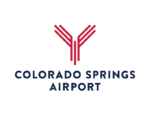 | |||||||||||||||||||
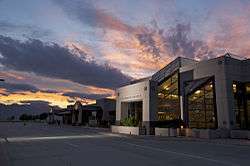 | |||||||||||||||||||
| Summary | |||||||||||||||||||
| Airport type | Public | ||||||||||||||||||
| Owner/Operator | City of Colorado Springs | ||||||||||||||||||
| Serves | Colorado Springs, Colorado | ||||||||||||||||||
| Elevation AMSL | 6,187 ft / 1,886 m | ||||||||||||||||||
| Coordinates | 38°48′21″N 104°42′03″W / 38.80583°N 104.70083°WCoordinates: 38°48′21″N 104°42′03″W / 38.80583°N 104.70083°W | ||||||||||||||||||
| Website | Colorado Springs Airport | ||||||||||||||||||
| Maps | |||||||||||||||||||
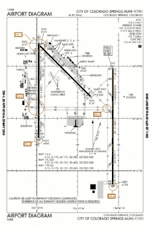 FAA airport diagram | |||||||||||||||||||
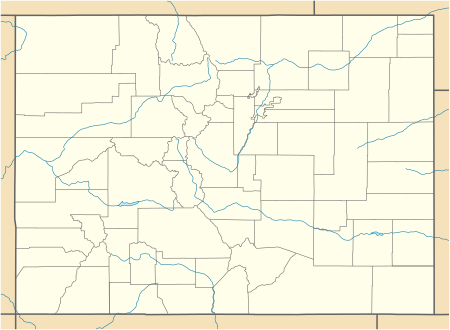 COS Location of airport in Colorado  COS COS (the US) | |||||||||||||||||||
| Runways | |||||||||||||||||||
| |||||||||||||||||||
| Statistics | |||||||||||||||||||
| |||||||||||||||||||
City of Colorado Springs Municipal Airport[2] (IATA: COS, ICAO: KCOS, FAA LID: COS) (also known as Colorado Springs Airport[1]) is a city-owned public civil-military airport 6 miles (9.7 km) southeast of Colorado Springs, in El Paso County, Colorado.[2] It is the second busiest commercial service airport in the state. Peterson Air Force Base, which is located on the north side of runway 13/31, is a tenant of the airport.
History
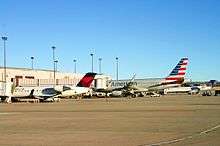
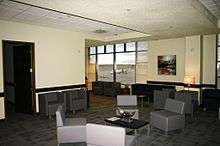
In 1927 the airport opened on 640 acres (260 ha) 7 miles (11 km) east of the city, with two gravel runways. In the late 1930s the first scheduled airline flight went from El Paso, Texas, through Pueblo, Colorado Springs, to Denver and back. The first municipal terminal was built in 1942 in an art deco style. Soon after the terminal was built the field was taken over by the military in the months preceding World War II. After the war, the city regained control.
In 1966 a new terminal was built on the west side of the runways, just east of Powers Boulevard. This terminal expanded by the 1980s, with a six gate addition. By 1991 the airport had three 150-foot (46 m) wide runways, one 13,501 feet (4,115 m) long, making it the longest runway in Colorado until 16R/34L, a 16,000-foot (4,900 m) runway, opened at Denver International Airport in September 2003. In 1991 the city approved a new terminal, two miles east of the former terminal, in the south-center part of the airport. The 280,000-square-foot (26,000 m2) terminal opened on October 22, 1994 with 12 gates; it was designed by the Van Sant Group and cost $140 million.[3] In the 1990s a second, 5-gate concourse was added on the east side of the main terminal.
In 1996, the 1941 passenger terminal, two hangars, and a caretaker residence — by that time all located on Peterson Air Force Base — were inscribed on the National Register of Historic Places. They form the campus of the Peterson Air and Space Museum.[4][5]
Commercial Service
Through the 1970s, 1980s, and 1990s, the airport tried to expand service. The largest number of passengers was nearly 5 million in 1996 when now-defunct Western Pacific Airlines had a hub at COS (they moved it to Denver International Airport in late 1996). Their timetable for 15 June shows 33 daily departures to 20 airports between the west coast and Newark and Washington Dulles. (All their flights left from or landed at COS).
In 2012, Frontier Airlines attempted to build a focus city at COS with added nonstop service to a number of destinations including Los Angeles, Orlando, Phoenix-Sky Harbor, Portland, OR, San Diego and Seattle–Tacoma in addition to existing daily flights to their Denver hub. In 2013, Frontier discontinued all service from COS citing that performance on the newly served routes were not meeting expectations. Frontier returned to COS in 2016 with nonstop service to Las Vegas, Phoenix-Sky Harbor, and Orlando with plans to grow to 15-20 destinations within 3 to 5 years. In March 2017, Frontier announced 7 new seasonal cities from COS including Chicago O'Hare, Los Angeles, San Francisco, San Diego and Washington to begin summer 2017 and Ft. Myers and Tampa to begin fall 2017.
Colorado Springs currently has non-stop flights to 17 U.S. cities on 4 carriers.
Facilities and aircraft
The airport covers 7,200 acres (2,900 ha) and has three paved runways: 17L/35R, 13,501 ft × 150 ft (4,115 m × 46 m) long, 17R/35L, 11,022 ft × 150 ft (3,360 m × 46 m) and 13/31, 8,270 ft × 150 ft (2,521 m × 46 m).[2]
Reached via Milton Proby Parkway, the terminal consists of two concourses. However, only one, the larger concourse housing gates 1–12, has ever been put to commercial use; the second concourse (called the Western Pacific Airlines concourse) contains gates 14–18 (there is no gate 13) and is now mainly used for meetings. Access between the concourses requires leaving the secure area, walking through the main terminal and down a long hallway.
Since September 2011 the airport terminal has been under renovation, that includes reconstruction of the TSA checkpoint to support full body scanners, expansion of office space behind the ticket counters, and new facilities for automated baggage screening.
Repairs to runway 17L/35R, first scheduled for 2011, were delayed to spring 2012 by the FAA shutdown.
In the year ending December 31, 2017 the airport had 135,178 aircraft operations, an average of 370 per day: 48% general aviation, 31% military, 11% scheduled commercial , and 10% air taxi. In April 2018, there were 231 aircraft based at the airport: 151 single-engine, 25 multi-engine, 25 jet, 4 helicopter, and 26 military.[2]
Airlines and destinations
Passenger
| Destinations map |
|---|
 Colorado Springs Destinations from Colorado Springs Airport (Red) = Year-round Destination (Green) = Seasonal Destination |
Cargo
| Airlines | Destinations |
|---|---|
| FedEx Express | Memphis, Grand Junction, San Bernardino |
Statistics
Top destinations
| Rank | City | Passengers | Carriers |
|---|---|---|---|
| 1 | 194,920 | American | |
| 2 | 137,230 | United | |
| 3 | 116,020 | American, Frontier, United | |
| 4 | 62,140 | Frontier | |
| 5 | 53,220 | United | |
| 6 | 49,540 | Delta, Frontier | |
| 7 | 47,860 | United | |
| 8 | 43,120 | Frontier | |
| 9 | 39,390 | Frontier | |
| 10 | 28,630 | Delta | |
Accidents and incidents
- On March 3, 1991, United Airlines Flight 585, a Boeing 737-291 flying from Peoria, Illinois, to Colorado Springs via Moline, Illinois, and Denver, Colorado, crashed on final approach to Colorado Springs Runway 35 after a rudder malfunction caused the aircraft to roll over and dive, killing all 25 on board.
- On December 30, 2010, a Delta Air Lines Boeing 757-300 operating as Flight 1921 from Detroit Metropolitan Wayne County Airport to Phoenix Sky Harbor International Airport with 225 passengers and crew had to make an emergency landing at the airport due to engine problems. Two people were injured during the evacuation.
- On April 16, 2018, a fire broke out on the airport's roof. There were no casualties, but the event resulted in the airport being closed at least for the next few days.[7]
See also
References
- 1 2 Colorado Springs Airport, official web site
- 1 2 3 4 5 FAA Airport Master Record for COS (Form 5010 PDF), effective April 26, 2018
- ↑ "Colorado Springs Airport -". Springs Gov.
- ↑ Mehls, Steven F. (March 1, 1996), National Register of Historic Places Registration Form: Original Colorado Springs Municipal Airport (PDF), retrieved February 21, 2018 .
- ↑ National Park Service (November 22, 1996), Weekly List of Actions Taken on Properties: 11/11/96 through 11/15/96, archived from the original on May 26, 2017, retrieved February 21, 2018 .
- ↑ "RITA BTS Transtats - COS". www.transtats.bts.gov. June 2018.
- ↑ "Colorado Springs Airport cancels commercial flights after rooftop fire". Denver Post. April 17, 2018.
External links
- Colorado Springs Municipal Airport at Colorado DOT website
- FAA Airport Diagram (PDF), effective October 11, 2018
- Resources for this airport:
- AirNav airport information for KCOS
- ASN accident history for COS
- FlightAware airport information and live flight tracker
- NOAA/NWS latest weather observations
- SkyVector aeronautical chart for KCOS
- FAA current COS delay information
- flight path in Colorado Springs
